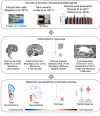Molecular neuroanatomy of anorexia nervosa
- PMID: 32651428
- PMCID: PMC7351758
- DOI: 10.1038/s41598-020-67692-1
Molecular neuroanatomy of anorexia nervosa
Abstract
Anorexia nervosa is a complex eating disorder with genetic, metabolic, and psychosocial underpinnings. Using genome-wide methods, recent studies have associated many genes with the disorder. We characterized these genes by projecting them into reference transcriptomic atlases of the prenatal and adult human brain to determine where these genes are expressed in fine detail. We found that genes from an induced stem cell study of anorexia nervosa cases are expressed at higher levels in the lateral parabrachial nucleus. Although weaker, expression enrichment of the adult lateral parabrachial is also found with genes from independent genetic studies. Candidate causal genes from the largest genetic study of anorexia nervosa to date were enriched for expression in the arcuate nucleus of the hypothalamus. We also found an enrichment of anorexia nervosa associated genes in the adult and fetal raphe and ventral tegmental areas. Motivated by enrichment of these feeding circuits, we tested if these genes respond to fasting in mice hypothalami, which highlighted the differential expression of Rps26 and Dalrd3. This work improves our understanding of the neurobiology of anorexia nervosa by suggesting disturbances in subcortical appetitive circuits.
Conflict of interest statement
The authors declare no competing interests.
Figures






References
-
- Zipfel S, Löwe B, Reas DL, Deter HC, Herzog W. Long-term prognosis in anorexia nervosa: lessons from a 21-year follow-up study. Lancet. 2000;355:721–722. - PubMed
-
- Watson HJ, Bulik CM. Update on the treatment of anorexia nervosa: review of clinical trials, practice guidelines and emerging interventions. Psychol. Med. 2013;43:2477–2500. - PubMed
-
- Sullivan PF. Mortality in anorexia nervosa. Am. J. Psychiatry. 1995;152:1073–1074. - PubMed

